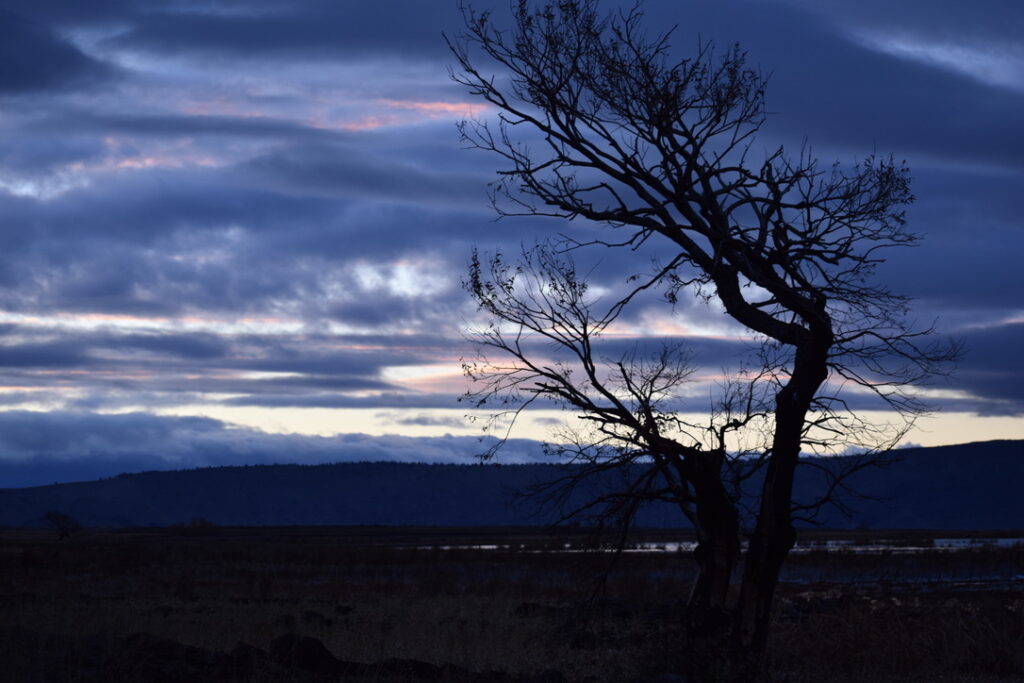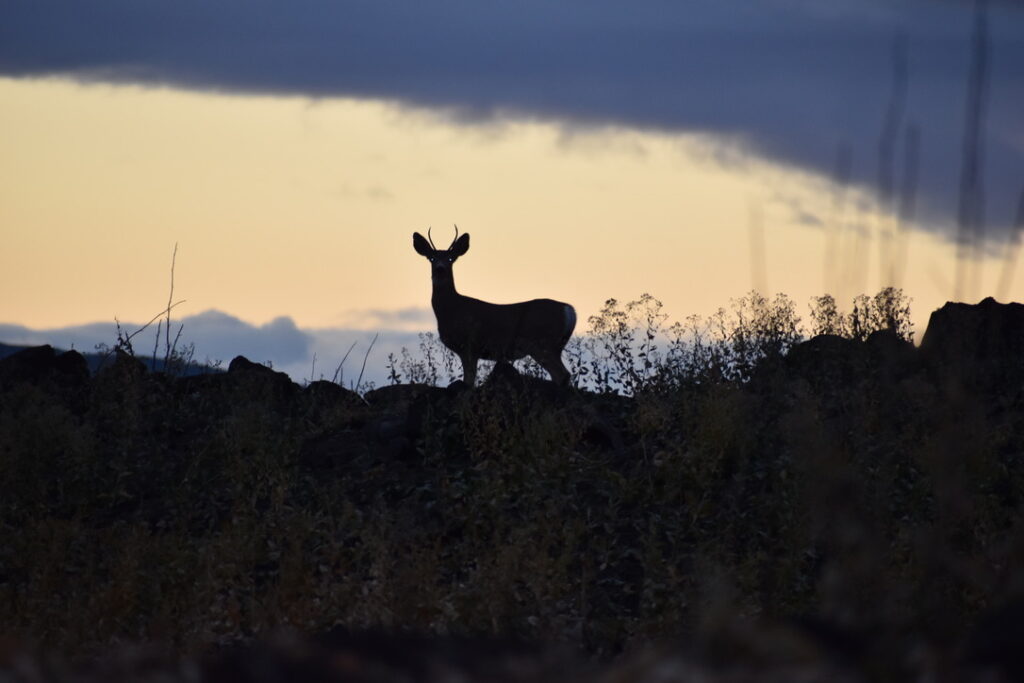
Part 5 – Amid Tears and Sorrow
The land is black and stinks of ash resin. Against purple skies, a hobbled tree stretches its blackened branches as if reaching for help. To my right, the surface of Tule Lake reflects the failing light between tule reeds huddled together in the shallows. I’ve returned to the southern shores of the lake seeking goose music.
I follow a path to a viewing blind. When I walked this past last year, the path was overgrown, choked with short bushes that had spread themselves across the path like it was their living room. It had been a foggy morning, and I nearly lost my bearings on the return trip. Now it’s easier to see my destination, but the path itself is even more difficult to find, as the choking bushes and topsoil alike have been reduced to a layer of black grime.
On my mind is a conversation on the New Yorker Radio Hour, between Music Critic Alex Ross, Cellist Yo-Yo Ma, and Pianist Emmanuel Ax that I listened to on the drive. Beethoven’s Cello Sonata No. 3, which Ma and Ax recently took on tour to hospitals, and performed for doctors and nurses treating COVID-19 patients, “has that quality of serenity of contentment and joyfulness,” Ax says. The piece was written amidst Beethoven’s loss of hearing and just after Napoleon’s armies had invaded Austria. “And between that, what’s going on around him in the city, what’s going on in the country,” Ax says, “there’s this music which is hopeful, beautiful, generous.”
“But it’s not an oblivious kind of joy,” he says. Beethoven inscribes his sonata “Amid tears and sorrow.”
Surveying the destruction around me, I wonder how to find that sort of hope.

2020 saw wildfires raging across the state. This one burned over 100 square miles from here to the south of Lava Beds National Monument as a part of the July Complex. Caused by lightning strikes that sparked three different fires, the drought-stressed grasses, brush, and timber quickly spread the flames. It took firefighters nearly a month to bring the fire to containment. Much of the water used to fight the fires was the same water that has been diverted and drained from this land, a point that supporters of water diversion are quick to point to. If we didn’t have the reservoirs, they argue, how would we fight the fires? It seems sensible, but much like a smoker who soothes anxiety with another cigarette, it mistakes one of the causes for a cure.
A direct line between the water diversions and the fires may be difficult to draw—California’s wildfire problem is complex and interrelated—but substantial evidence allows us to infer the shape of the web, and water diversion is clearly one strand. Humans have changed the land, and the land is now sick. Indirectly, the results of diversion—species disruption, erosion, climate change—have secondary effects that contribute to fires that are far more destructive and wide-ranging than ever before in the recorded history of California.
I crest a small burm and startle a bevy of deer from their dinner. Their ribs are visible through the rough shag of their coats. I wonder at the meager scraps of grass trying to find a foothold in the charred earth. Will they provide enough food to support the deer population? Will this area grow back at all? California has always had fire, I know, but recent years have been distinctly different: they often burn so hot as to decimate the topsoil and render it uninhabitable for most species of plants.

A small bridge has been burnt down to the concrete ends that once supported it, and I have to detour slightly to cross at the end of the channel. With no grasses to hold it back, the dirt here has collapsed down the slope.
John Muir, writing in 1912, already knew the importance of vegetation in holding back not only erosion, but water itself. “The thirsty mountaineer knows well that in every sequoia grove he will find running water, but it is a mistake to suppose that the water is the cause of the grove being there; on the contrary, the grove is the cause of the water being there. Drain off the water and the trees will remain, but cut off the trees, and the streams will vanish.”
We now know that not only the Sequoias, but every plant, harvests and stores water to release it gradually over time. It allows for a more even distribution of water over time, protects the soil and the whole ecosystem from the worst ravages of drought. With nothing to check the rain and melting snow, erosion, flooding, and the silting of reservoirs follows. Water that once remained in the land runs off fast, fills the reservoirs too quickly, reduces their capacity, and must be sent on its way so it doesn’t overwhelm the reservoirs.
On its way, it carries off the nutrients that once made this region so fertile for crops. The water that does collect in the reservoirs is filled with these nutrients, as well as pesticides and fertilizer runoff. The reservoirs form massive algae blooms, killing fish and waterfowl.
The spiral continues downward.
I find my way to the wildlife viewing blind, up on a manmade hill near the edge of the lake and somehow still standing amongst all this ruin. Was this only saved because it is a human structure? The last remaining light in the sky glints off the lake some dozen feet below me, and a few birds leave small wakes on the surface.
The difficulty of caring for the environment is that one is constantly walking a tightrope between despair and hope. One must beat the drum of doom, cajoling others to care and take action, but fall into despair and any action seems fruitless. One needs a little hope: that water can be shared, that the cattle-centered crops might be shifted to more sustainable and fruitful crops. False optimism, of course, runs the danger of encouraging complacency. The optimistic belief that some new technology will save us from climate change keeps us from taking the actions that are already available to us.
While I sit on the cold bench in the blind, looking out at the sparsely-populated lake, watching duck wakes spread across the pond and fade to stillness, these thoughts and the lingering memories of Beethoven’s Cello sonata begin to recede into the background. That’s when I notice the music around me. It’s a distant sound, coming from high above, but it’s a cacophony, a three-dimensional music. I rise in the dark, step out of the blind and look up. Geese, thousands of them, are flying in overlapping v-shaped formations, honking with loose, giddy abandon. They stretch as far as I can see, from the edge of the last murky light in the east, passing above me in waves of wake-like wedges, and disappearing out of sight over the western ridge.
I remain until well past the last dim light has faded, sitting in dirt and black ash. After I rise, beat the stinking soot from my pants, and pick my way back to the car in the darkness, the goose music remains.
Beautifully written.